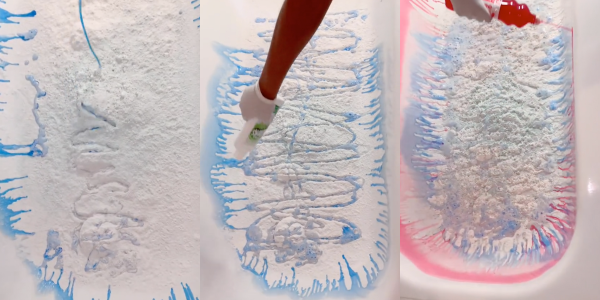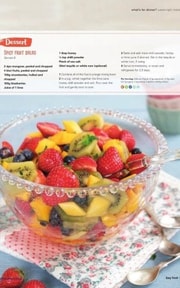The 'Product Overload' cleaning trend popularised on social media is dangerous—Here's why you should avoid it!
By
VanessaC
- Replies 8
If you’ve seen the ‘Product Overload’ trend on social media—better watch out, as it’s a trend you should skip.
The mesmerising videos may look fun and satisfying, but this ‘hack’ comes with some serious risks and has proven to be more dangerous than helpful.
This cleaning trend involves clearing out an entire cupboard of cleaning products before pouring it all over the toilet, sink, or bathtub.
It’s become so popular that the hashtag #productoverload currently has over 780 million views, and it’s important to learn why the product overload challenge is a definite no-go in cleaning.
The ‘Product Overload' cleaning trend’s dangers
Jessica Ek, Senior Director of Digital Communications at the American Cleaning Institute, discussed why this trend should be avoided and gave safer alternatives to sparkling your home in no time!
1. It’s dangerous to your health.
Ek explains that combining many different cleaning products is a pretty bad idea—not only because it is a waste of product but because certain chemical combinations release poisonous gas when they interact with one another, making it harder to breathe and may cause chemical burns to the skin, eyes, throat, nose, and lungs.
For example, combining bleach and ammonia produces chloramine gas, while bleach and vinegar will create chlorine gas. Even with the use of protection such as masks and gloves, it’s best not to take the risk with this latest cleaning craze.
2. It can damage fixtures and pipes.
Apart from the risk to humans, the trend also has the potential to wreak havoc on your fixtures and plumbing, as many cleaning products are formulated to work with specific materials only, such as glass, porcelain, or stainless steel. Other cleaners are meant to be diluted so that they’re strong enough to clean surfaces but won’t damage piping.
You could face a hefty plumbing bill after your pipes become clogged or corroded with excessive amounts of product. You might also need to replace a sink, toilet, or tub due to the abrasive cleaners that scratched the surfaces of those fixtures beyond repair.
'Choose a product specifically formulated for what you want to get clean and follow the cleaning product label instructions [to] make sure the product is safe for the area being cleaned,' Ms Ek said.
You can watch one video from the trend below:
3. It’s wasteful, and 'more doesn’t always mean better'.
Not only is emptying an entire bottle of toilet bowl cleaner wasteful, but it can also create a world of problems by flooding sewage systems with excess chemicals and polluting landfills with product packages.
'It’s not necessary to get things clean, in addition to being a waste of product and money,' Ms Ek said.
Below is another video from the 'Product Overload' trend:
Safer alternatives to the 'Product Overload' trend
Ms Ek emphasised that messes aren’t always a one-and-done type of situation, she explained: 'It may take more than one cleaning to remove stains and grime that have built up over time.'
So it’s okay not to get it right the first time, so long you stick to the designated purpose of the commercial cleaners you use.
Moreover, Ms Ek gave some alternatives for a healthier and more environmentally friendly clean.
1. Toilet Bowls
Use either white vinegar or hydrogen peroxide (but not both, as they can cause an acidic reaction!) and pour it above the bowl’s ring line. Let the solution sit for a while (overnight, if possible), throw in some bicarb soda, then scrub and flush.
Adding bleach to water and scrubbing with a brush or a pumice stone for tougher stains can help.
2. Bathtubs
First, check with the tub’s manufacturer to find out what cleaners are safe. With that in mind, dilute bleach with water and clean the surface with a sponge or brush. Don’t forget to wear gloves! Allow it to sit for a few minutes before rinsing thoroughly.
For soap scum and other stubborn stains, see which method below won’t damage your bathtub:
3. Sinks
Depending on the material used for your sink, the following techniques will help keep it clean and sparkly:
Again, leave the solution for at least 30 minutes before rinsing and wiping with a microfibre cloth.
 What do you think about this trend, dear members? Do you have other (and safer!) tips on how to clean these fixtures at home? Share them with us in the comments below!
What do you think about this trend, dear members? Do you have other (and safer!) tips on how to clean these fixtures at home? Share them with us in the comments below!
The mesmerising videos may look fun and satisfying, but this ‘hack’ comes with some serious risks and has proven to be more dangerous than helpful.
This cleaning trend involves clearing out an entire cupboard of cleaning products before pouring it all over the toilet, sink, or bathtub.
It’s become so popular that the hashtag #productoverload currently has over 780 million views, and it’s important to learn why the product overload challenge is a definite no-go in cleaning.
The ‘Product Overload' cleaning trend’s dangers
Jessica Ek, Senior Director of Digital Communications at the American Cleaning Institute, discussed why this trend should be avoided and gave safer alternatives to sparkling your home in no time!
1. It’s dangerous to your health.
Ek explains that combining many different cleaning products is a pretty bad idea—not only because it is a waste of product but because certain chemical combinations release poisonous gas when they interact with one another, making it harder to breathe and may cause chemical burns to the skin, eyes, throat, nose, and lungs.
For example, combining bleach and ammonia produces chloramine gas, while bleach and vinegar will create chlorine gas. Even with the use of protection such as masks and gloves, it’s best not to take the risk with this latest cleaning craze.
2. It can damage fixtures and pipes.
Apart from the risk to humans, the trend also has the potential to wreak havoc on your fixtures and plumbing, as many cleaning products are formulated to work with specific materials only, such as glass, porcelain, or stainless steel. Other cleaners are meant to be diluted so that they’re strong enough to clean surfaces but won’t damage piping.
You could face a hefty plumbing bill after your pipes become clogged or corroded with excessive amounts of product. You might also need to replace a sink, toilet, or tub due to the abrasive cleaners that scratched the surfaces of those fixtures beyond repair.
'Choose a product specifically formulated for what you want to get clean and follow the cleaning product label instructions [to] make sure the product is safe for the area being cleaned,' Ms Ek said.
You can watch one video from the trend below:
3. It’s wasteful, and 'more doesn’t always mean better'.
Not only is emptying an entire bottle of toilet bowl cleaner wasteful, but it can also create a world of problems by flooding sewage systems with excess chemicals and polluting landfills with product packages.
'It’s not necessary to get things clean, in addition to being a waste of product and money,' Ms Ek said.
Below is another video from the 'Product Overload' trend:
Safer alternatives to the 'Product Overload' trend
Ms Ek emphasised that messes aren’t always a one-and-done type of situation, she explained: 'It may take more than one cleaning to remove stains and grime that have built up over time.'
So it’s okay not to get it right the first time, so long you stick to the designated purpose of the commercial cleaners you use.
Moreover, Ms Ek gave some alternatives for a healthier and more environmentally friendly clean.
1. Toilet Bowls
Use either white vinegar or hydrogen peroxide (but not both, as they can cause an acidic reaction!) and pour it above the bowl’s ring line. Let the solution sit for a while (overnight, if possible), throw in some bicarb soda, then scrub and flush.
Adding bleach to water and scrubbing with a brush or a pumice stone for tougher stains can help.
2. Bathtubs
First, check with the tub’s manufacturer to find out what cleaners are safe. With that in mind, dilute bleach with water and clean the surface with a sponge or brush. Don’t forget to wear gloves! Allow it to sit for a few minutes before rinsing thoroughly.
For soap scum and other stubborn stains, see which method below won’t damage your bathtub:
- Use bicarb soda and dish soap paste
- Use bicarb soda or cream of tartar and hydrogen peroxide paste
- Sprinkle bicarb soda, spray with white vinegar, and then scrub until a paste-like texture forms
3. Sinks
Depending on the material used for your sink, the following techniques will help keep it clean and sparkly:
- For stainless steel sinks, sprinkle bicarb soda and gently scrub with a dish soap-soaked sponge
- For white or porcelain sinks, use bicarb soda followed by hydrogen peroxide and gently clean with a sponge or brush
- For copper sinks: mix hot water with dish soap and wipe it down using a soft sponge or cloth
Again, leave the solution for at least 30 minutes before rinsing and wiping with a microfibre cloth.
Key Takeaways
- The 'Product Overload' trend on TikTok involves using excessive amounts of cleaning products to clean fixtures, potentially causing harm both to individuals and to plumbing systems.
- Health risks include respiratory problems and potential burns caused by the combination of certain cleaning agents.
- The unnecessary wastage of cleaning products and the potential damage and expenses caused to plumbing systems are other reasons to avoid following this trend.
- Jessica Ek from the American Cleaning Institute suggests using products specifically formulated for the surfaces being cleaned and following instructions to ensure safe use.









